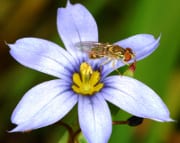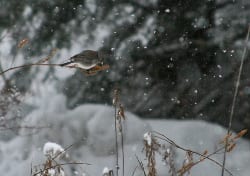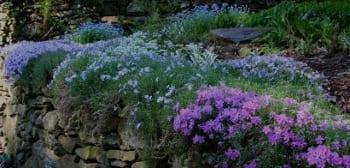by Ellen Sousa
The following excerpt is reprinted from The Green Garden (Bunker Hill Publishing, 2011) with the permission of the author.
Habitat gardening is just like planning and designing the interior of your home. You consider the everyday needs of those you invite into your space, furnish or rearrange the space accordingly, and stock the cupboards well. No matter what types of wildlife you would like to attract, remember the basics. All living things require food, water, shelter (from weather and predators) and a safe place to raise young.

Gardens with a mix of old and new trees, evergreen and deciduous vines, shrubs, perennials, grasses, rocks, and other natural objects provide food, nesting, and protection for birds, pollinators, and small creatures that comfortably coexist with us.

Insects and their larvae (caterpillars and grubs) are staple foods for most birds. Photo copyright Pat D. Hemlepp. Used with permission of the photographer.
Plant it, and they will come
Plants supply the seeds, berries, nuts, cones, buds, twigs, leaves, sap, flowers, nectar, and pollen that feed many birds and mammals. Plants shade the ground and drop their foliage, feeding soil-dwelling invertebrates and tiny decomposers that break down organic matter into rich soil. Plant foliage feeds many insects that are essential foods for birds, bats, dragonflies, spiders, and other wildlife. Plants also provide shelter from the elements, protection from predators, and safe places to build nests.

The braconid wasp is parasitizing a gypsy moth caterpillar. These small and inconspicuous wasps don't have a communal nest to defend, so they are unlikely to sting.
A toxic-free zone
It might seem counterintuitive to a new gardener, but the presence of a variety of insects in a garden is what keeps it healthy. Insects support most higher life forms, either directly or indirectly, and their presence attracts natural enemies such as birds and predatory insects who control their populations naturally. Short-term, pesticides may reduce a pest problem, but most don’t discriminate between target pests and beneficial insects, and they destroy an ecosystem’s natural balance. Control pests by filling your gardens with a diversity of plants that feed birds and other predators. Birds feed hundreds of insects to their nestlings each day, and in an area with breeding birds, most pests don’t stand a chance of multiplying.
Although some microorganisms can adapt and even thrive in a toxic habitat, most higher life forms are extremely vulnerable to the presence of pesticides, fungicides and herbicides, and pesticide buildup is increasingly linked to major bee die-offs. Imidacloprid, widely used in the US for grub control, has now been banned in several countries

Pollinating insects that visit flowers are often gobbled by hungry predators, so it's no coincidence that many, like the hoverfly, have evolved stripes like their stinging relatives.
for its impact on honey bees. Many pesticides bioaccumulate through the food chain, with higher members carrying heavy loads.
There’s safety in thickets
Birds and other wildlife will visit your yard only if they feel safe from cats, hawks, and other predators. And they’ll usually build their nests in spots they instinctively know are safe. Plant groupings of trees, shrubs, and other plants to form thickets where birds can safely feed, take cover, and build nests. Include evergreens such as spruce, juniper, pine, hemlock, and rhododendron to provide cover and shelter in winter, as well as plants with thorns or twiggy branch structures to protect small songbirds and their nests.

The structure of your plantings is important in a habitat garden. In winter, the evergreen hemlock, juniper, rhododendron, and mountain laurel provide safe places for birds to shelter. Juniper, with its scratchy foliage that cats dislike, is a good pace for a summer birdbath.
Climbing vines connect the ground with the upper tree canopy by traveling in, around, and up any surrounding plants, providing a link between lower and higher levels of the habitat. Connect garden beds, woodland edges, and other boundaries to link habitats and create corridors that provide safe travel between feeding, nesting, and watering areas.
To create the most biodiversity in your garden, mimic the layered effect found in nature by underplanting large trees with smaller trees and shrubs, adding vines, and covering the ground layer with shorter plants that protect and nurture the soil. Each layer of vegetation you add to your habitat increases the niche habitat conditions available and the number of species your area will support.

Many birds have very specific nesting requirements. The wood thrush nests only in shrubs surrounded by tall shade trees. This songbird with a beautiful flute-like song migrates from Mexico and South America to New England's forests in spring and is suffering population declines because development in northern US forests increases populations of nest predators.

This yellow-bellied sapsucker taps a hole in thin-barked trees, slurps the sweet liquid, and eats insects.
Dead and dying wood
In the formal landscape, dead trees are cut down and dead branches removed. However, snag (dead or dying trees) and fallen logs are important microhabitats, providing food and homes for a myriad of living creatures, most of them very tiny. Insects, arthropods, and a host of fungal organisms all make use of old wood, as well as many birds. Try to find opportunities to integrate the shapes and forms of dead or declining trees into your landscape. For a badly damaged tree, cut off only those branches that pose a danger should they fall, and leave as much stump as you can. Fungi will rot down the dead wood into soil; you can speed up the decomposition process by drilling holes or sawing crosscuts in the stump and keeping it moist. Buy edible or medicinal mushroom spores from a supplier and inoculate the stump to create your own edible mushroom factory, at the same time hastening the stump’s demise.
Use its broken branches to build a log or brush pile as protective shelter and safe sanctuary for wildlife. Chickadees and thrushes, as well as chipmunks, turtles, toads, and salamanders will all use a brushpile for cover, at the same time dining on the centipedes, pillbugs, and other decomposers working to soften and breakdown old wood. Winter wrens and white-throated sparrows nest inside brushpiles, and towhees on the ground underneath. Hummingbirds, dragonflies, and American phoebes like to perch on the twigs and small branches that protrude from brushpiles.

A relaxed garden style makes yardwork easier on you and better for wildlife. Seed clusters left standing on stems are important bird forage when the snow has buried other food sources.
A living soil
Lawns and gardens free of chemical fertilizers and pesticides contain soil that feeds and houses life at the base of the food chain. A living soil contains billions of mircroorganisms, plus larger life forms such as earthworms, beetles, ants, centipedes, millipedes, slugs, springtails, and mites, which feed on organic and mineral matter and recycle their nutrients back into the soil. Feeding and mulching gardens with any plant material, including compost, dry leaves and bark mulch, builds healthy populations of these beneficial soil organisms. Instead of cleaning your gardens in the fall, allow plant stems to remain in place through the winter and allow leaves to accumulate under trees and shrubs and in beds. Seeds feed hungry winter birds, and many beneficial insects hibernate in leaf litter and hollow plant stems. Leaf litter is also important for declining amphibians such as toads, frogs and salamanders, who help control soil dwelling insects.

Gardens mulched with leaves host many insects that feed ground-feeding birds such as eastern towhees (above), ovenbirds, and brown thrashers.
In spring, you can clean up your beds by gently raking out large debris, but leave some of the plant remains (chop them up with a pruner or shredder for a neater look) as nutritious soil mulch. Nature’s cleanup crew will break them down into plant food.
Leave a few areas of soil undisturbed and untilled to protect the underground nest structures excavated by ground-nesting pollinators, including sand, digger, and sweat bees, which lay their eggs in tiny tunnels excavated in bare soil, sandy banks, or under leaf litter. Loose, sandy soils are nesting habitat for a variety of rare birds and turtles, but because of shoreline development, recreational use of sandy beaches and dunes, and vehicle traffic in old sandpits, they are among the most heavily disturbed and endangered soil habitats in New England.
Bare and dusty areas are also used by birds to take a dust bath, which they do to balance the oils in their feathers and control parasites.
Rocks and stone walls
Thanks to the Ice Age glacial action and our more recent agricultural history, rocks and stone walls are ubiquitous in New England’s landscape. Frustrated colonial farmers built stone walls from rubble that filled their fields. Many are still standing today, providing homes and passageways for wildlife, as well as a visible link to a historical way of life. Unmortared or dry stone walls provide many nooks and crannies where frogs, salamanders, and snakes can hide, and nocturnal mammals such as bats can rest during the day. Walls provide protective cover for small mammals and turtles and other reptiles.

Spring-flowering moss phlox and candytuft thrive with the excellent drainage and shallow soil at the top of a sunny rock wall. Pinks bloom afterward.
Try to incorporate existing rocks and boulders into your landscaping, or “plant” locally sourced rocks into your landscape. The soil underneath will eventually host soil-dwelling arthropods and microbes that live on the minerals leaching from stones, recycling the nutrients for nearby plants to use. Over time, your rocks will develop interesting lichens and mosses that form their own microhabitats. Even steps and paths made of stone slabs can provide homes for invertebrates that tunnel underneath rocks, including ground beetles and pillbugs, both beneficial decomposers and food for many creatures.

A beautiful streetside garden makes creative use of the rocks uncovered during excavation in this Massachusetts subdivision.
Water
Without clean water, wildlife cannot survive for long, especially during winter freezes when many water sources are inaccessible. At the other extreme, a stream, pond, or even a boggy area on or near your property immediately increase the number of wildlife species that can use the area. Best of all, the many beautiful plants that grow in and around water make waterside gardening a joy.

The sound of moving water is soothing for human visitors, but a landscaped water feature will also attract winged visitors.
Water isn’t difficult to add to your landscape, and birds will usually appear almost immediately if you install a water feature. Water also attracts turtles, frogs, toads, salamanders, dragonflies, damselflies, bats, and other beneficial wildlife. A simple hole dug in the ground, lined with PVC or rubber, can get you started with a backyard water feature, or you can buy preshaped ponds and waterfalls from garden supply stores.

A stone birdbath is shallow enough to provide a perfect drinking hole for butterflies and other tiny pollinators attracted to nearby flowering plants.
Or place a birdbath under a window, add a solar fountain or dripper, and sit back and enjoy the show. Birds love the sound of moving water and will investigate as soon as they dare.
About the Author
Ellen Sousa, author of The Green Garden, is a garden coach who helps local gardeners build, maintain, and nurture safe, healthy, and beautiful landscapes. She writes and speaks about habitat gardening with an emphasis on native plants.



